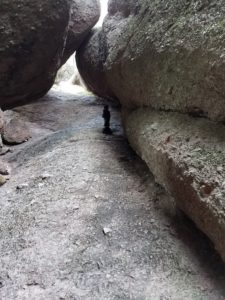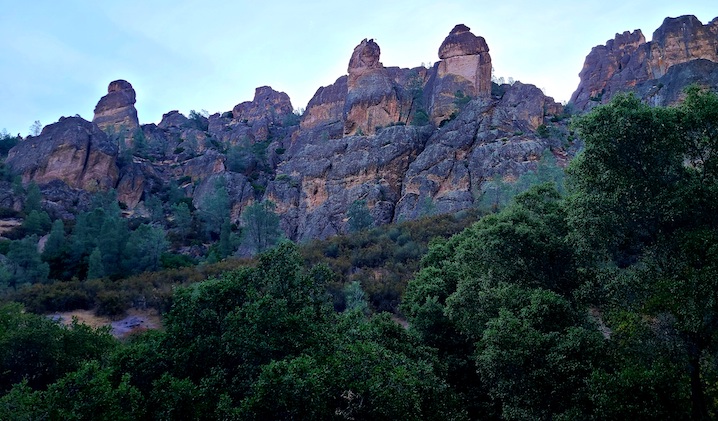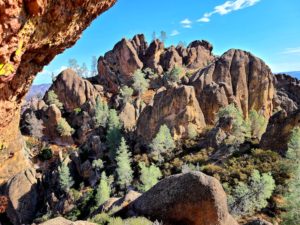Millions of years and multiple volcanic explosions of molten rock give you the unique sculpted landscape of towers and spires found at Pinnacles National Park. The Pinnacles Volcanic Field was born just north of what is now Los Angeles, CA. With a shotgun seat on the San Andreas fault line, it inches ever forward over millions of years to where it is now outside of Soledad, CA. And you thought LA traffic was slow!. The landscape affords visitors a variety of outdoor experiences, including rock climbing, hiking, cave exploration, or birdwatching. You can take an easy family-friendly trail or get a strenuous workout that gains serious elevation. Pinnacles National Park has what you’re looking for.
Table of Contents
Things to Do
The first thing to do is to choose which side you will enter the park. The east entrance is between Hollister and King City on Hwy 25. There is a bookstore on the east side open Thursday to Monday if you are interested in purchasing a souvenir. Visiting from Monterey or another spot on the Central Coast, the west entrance is off Hwy 101 outside of Soledad.
We came in on the west side and were at the gate when it opened at 7:30 AM. No permits are required for hikes. If going in the summer months it is best to start early and get a jump on the heat. A small visitor center is just past the gate where you pay an entrance fee of $30 or you can use your America the Beautiful pass. Check the Pinnacles National Park website for the most up-to-date information by clicking here.
Get Your Travel Goals Newsletter & BONUS Workbook
Seeing the Caves

Driving up to the Chaparral Parking Area we easily found parking and restrooms. My first trip to the Pinnacles was a trip with the boys to the caves. The Balconies Cave Trail and Balconies Cliff Trail loop in and out for just under 2.5 miles. Whether considering cave exploration at Bear Gulch Cave or Balconies Cave please check the NPS website for closures. The caves are home to bat colonies that may be in hibernation during your visit.
High Peaks Trail
For this most recent trip, we loaded up on water and snacks then headed southeast from the lot to take the Junipero Canyon Trail. We walked this short trail to connect with the High Peaks Trail – Condor Gulch Loop. In total, the hike takes about three to four hours depending on the number of breaks you need. Heat in summer is no joke so start the trail as early as possible. Bring plenty of water and know your pace. Take advantage of shady spots and vista points to take breaks. The High Peaks, made up of reddish breccia, are otherworldly. And as a result, you’ll find no shortage of places to stop and take pictures.

After a series of switchbacks that take you up a robust elevation change of 1,200+ feet in just a few miles, the vista point has a bench so take a seat, have a drink, and enjoy the vast expanse of the west side of the park. From here you see why the area was designated a National Monument in 1908 by then-President Roosevelt and became the 59th of 62 National Parks in 2012. When we went the sunlight was just inching down the spires and the condors were stretching their wings. Get a sense of how far you’ve come by looking all the way down to the Chaparral Parking Area and appreciate the fact that you’ve made it to the heart of the High Peaks. The red color of the rocks stands out in contrast to the blue sky, birds are flying by at eye level, and it’s simply beautiful.

Watching for Condors
Connecting with the trail again we found ourselves looping around to a section that changes to rough stairs carved into the rock. There are rails to help you negotiate the narrow trail. The view of the east side of the park opens up to you. While I never felt unsafe, Diego is not a fan of heights. He did not appreciate how narrow the trail became or how “close” we were to the view. But the reward was that we got up close and personal with a few of the condors in the area. Pinnacles has played a key role in condor reestablishment since the early 2000s. And thanks in large part to park efforts their numbers have grown significantly. Climbing down from the rocks you are back on the trail and begin your descent back down the switchbacks. Arriving back in the parking area before 11 AM leaves you feeling incredibly accomplished!
What to Bring
If you are entering the caves you’ll need headlamps for everyone. I don’t recommend flashlights as you’ll want your hands free to negotiate climbing in and out of the caves. Sunscreen and a hat are strongly recommended in the warmer months along with plenty of water. Bring snacks to re-energize throughout your hike. You may not get as close to the condors as we did so bring binoculars to watch them in action.
Teaching your kids about hiking safety is essential. Get our guide for what to teach your kids about hiking safety.
When you are ready to explore other California national parks grab our detailed posts on Yosemite and the nearby Sequoia and Kings Canyon National Park.
Or kick start an epic road trip from the central coast with our PCH adventure up to Redwood National Park.
If you are interested in other hikes in California on the Central Coast then check out what Cambria has to offer. There are amazing hikes in the area that you can take advantage of.

